Rayonnement Solaire |
Guide Pratique |
Page d'accueil OHP
 |
 |
 |
|
E.P.I.S.
Études Polaires par Interférométrie à
Svalbard
|
|
Study of Aurorae in the Polar Cap
Versions : 

| Scientific Staff : |
G. Thuillier,
M. Hersé, Service d'Aéronomie, CNRS
C. Lathuillere, J. Lilensten,
Laboratoire de Planétologie de Grenoble
J.-M. Perrin,
Relations Terre-Soleil, Observatoire de Haute-Provence
|
| Technical Staff : |
F. Huppert,
Relations Terre-Soleil,
Observatoire de Haute-Provence |
|

Polar aurora
|
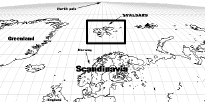
Location of measurements
|
Scientific Objectives

Radar ESR at Svalbard
|
|
The scientific objectives of the EPIS instrument are the dynamics and the thermal
structure of the thermosphere and polar high altitude mesosphere. In this aim,
EPIS will make interferometric measurements of the horizontal and vertical wind
components and of the temperature above 80 km. Installed at Svalbard, EPIS will
allow studies using the observations of the ESR polar radar.
Proposed studies are summarised below:
- Observation and modelling of the neutral and ion dynamics, in particular
the neutral wind vertical component, which is an almost unknown domain.
- Relationships between the horizontal and vertical wind convergence.
- Relationships between the dynamics and the components of the
interplanetary magnetic field and study of the role of their sign.
- Relations with the aurora. Particular study of the sun aligned arcs
(THETA aurora).
- Study of diurnal and seasonal variations.
- Gravity wave study (origin, propagation direction and amplitude).
- Study of the atmospheric tide propagation and their restoration
after a magnetic storm.
|

A MICADO / EISCAT meridional
wind comparison.
|
|
| species |
altitude of maximum
emission (km) |
mesured
quantity |
wavelength
(nm) |
phase of reference
(nm) |
continuum
(nm) |
| O1S |
90 et 250 |
Un et Tn |
557,7 |
Kr (557,0) |
563 |
| O1D |
250 |
Un et Tn |
630 |
Ne (630,4) |
627 |
| OH |
85 |
Un et Tn |
686 |
Ar (680) |
685 |
| O+ |
250 |
Vi |
731,9 |
Ar (738,4) |
720 |
The expected accuracy is 5 m.s-1 on the wind measurements
and 10 K on the thermospheric temperatures.
|
Principle of the measurements

The EISCAT radar and MICADO
interferometer.
|
|
The light emission from the planetary atmospheres contain specific information
on their environment :
- The wavelength identifies the species.
- The intensity provides their abundance.
- The spectral line width allows to derive the value of the thermodynamic temperature.
- The difference between the observed and laboratory line phases allows
to mesure the atmospheric velocity.
The choice of atmospheric lines is based on several criteria:
- Their intensity.
- Their separation with respect to neighbouring lines emitted by the
same species or by other species.
- the altitude of emission.
- Their thermalization when they are used to measure the temperature.
|
Presentation of instrument
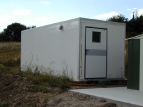
The EPIS shelter presently seen at OHP
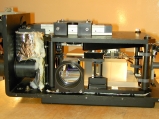
The Michelson interferometer
of the EPIS
instrument,
previously used in MICADO
|
|
EPIS uses a Michelson interferometer with a compensated field and automatic
compensation of its intrinsic phase. It analyses the phase variation and the
visibility of a natural emission, of which one deduces respectively the wind
velocity along the line of sight and the temperature. EPIS uses the lines of
oxygen O1D and O1S,
O+ and the emission of the radical OH. The previous
use of the MICADO instrument in the EISCAT site allowed to design a reliable
instrument, totally automatic which will be remotely operated from Observatoire
de Haute-Provence.
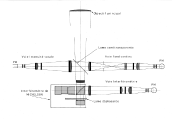
Experiment schematics |
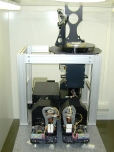
The EPIS instrument is funded
by the
Solar-Terrestrial National Program (INSU)
|
|
|
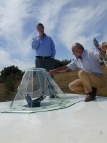
External view of dome

The viewing dome showing the
9 directions of
measurement
as presently seen at OHP
|
Site : the Aurora Page
http://www.geo.mtu.edu/weather/aurora
Janvier 2001
|